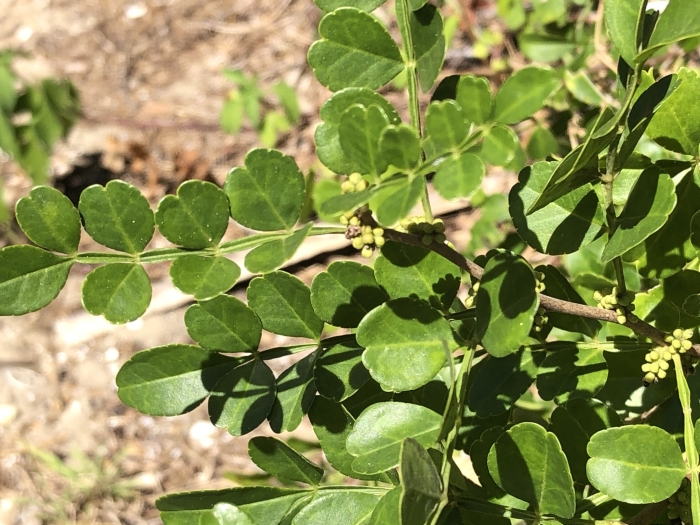Wild Lime
(Zanthoxylum fagara)
Wild Lime (Zanthoxylum fagara)
/
/

Pete Grannis
CC BY 4.0
Image By:
Pete Grannis
Recorded By:
Copyright:
CC BY 4.0
Copyright Notice:
Photo by: Pete Grannis | License Type: CC BY 4.0 | License URL: http://creativecommons.org/licenses/by/4.0/ | Rights Holder: Pete Grannis | Publisher: iNaturalist | Date Created: 2020-03-22T15:10:02Z |



















































Estimated Native Range
Summary
Zanthoxylum fagara, commonly known as Wild Lime, is an evergreen shrub or small tree native to coastal hammocks, pine rocklands, and tropical hardwood forests in the Americas, particularly in Florida, the Caribbean, and Central and South America. It typically grows to a height of 7 m (23 ft) with a trunk diameter of about 0.25 m (0.82 ft). The tree has a spreading habit and is characterized by its rough, gray bark and irregularly-shaped branches with hooked spines. The pinnate leaves are about 5 cm (2.0 in) long and, along with the bark, can be crushed to produce a bitter condiment with a citrus-like aroma. Wild Lime is known for its small, inconspicuous greenish-white flowers that bloom in spring and are followed by black, berry-like fruits that are attractive to birds.
Wild Lime is valued for its high drought tolerance and ability to grow in a variety of soil conditions. It is often used in native plant gardens, as a host plant for butterfly larvae, and for its ornamental spiny branches and aromatic foliage. It is best cultivated in full sun to part shade, with low to medium water requirements, and well-drained soils. While it is not commonly available in the nursery trade, it is sought after by enthusiasts of native plants and butterfly gardening. Gardeners should be aware that Zanthoxylum fagara can become invasive outside its native range, and its spines can make it difficult to handle.CC BY-SA 4.0
Wild Lime is valued for its high drought tolerance and ability to grow in a variety of soil conditions. It is often used in native plant gardens, as a host plant for butterfly larvae, and for its ornamental spiny branches and aromatic foliage. It is best cultivated in full sun to part shade, with low to medium water requirements, and well-drained soils. While it is not commonly available in the nursery trade, it is sought after by enthusiasts of native plants and butterfly gardening. Gardeners should be aware that Zanthoxylum fagara can become invasive outside its native range, and its spines can make it difficult to handle.CC BY-SA 4.0
Plant Description
- Plant Type: Tree, Shrub
- Height: 5-20 feet
- Width: 3-12 feet
- Growth Rate: Moderate
- Flower Color: N/A
- Flowering Season: Winter, Spring
- Leaf Retention: Evergreen
Growth Requirements
- Sun: Full Sun, Part Shade
- Water: Low, Medium
- Drainage: Medium, Fast
Common Uses
Butterfly Garden, Fragrant, Low Maintenance
Natural Habitat
Coastal hammocks, pine rocklands, and tropical hardwood forests
Other Names
Common Names: Lime Pricklyash, Colima, Uña De Gato, Corriosa
Scientific Names: , Zanthoxylum fagara, Zanthoxylum fagara var. fagara, Zanthoxylum insularis, Fagaras fagara, Xanthoxylum pterotum, Zanthoxylum torreyi,
GBIF Accepted Name: Zanthoxylum fagara (L.) Sarg.